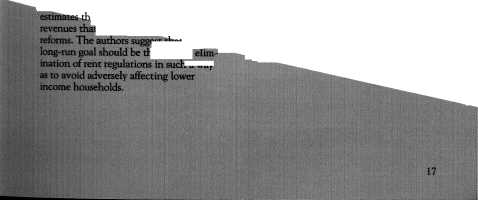the for units rises sharply
jt the that new construction
lit *uch units has been legally restricted
to conserve resources, as during wartime.
Absent conditions, unconstrained
to conserve resources, as during wartime.
Absent conditions, unconstrained
are the most efficient
and the only effective means of
and the only effective means of
an appropriate long-term bal-
ance of supply and demand in housing
markets.
ance of supply and demand in housing
markets.
The provides information
on the of rent controls on various
A 21-item bibliography is
included.
included.
The report discusses
for controls: (1)
for controls: (1)
units occupied by
holdb, (2) decontrol units
high rents, (3) decontrol 35
holdb, (2) decontrol units
high rents, (3) decontrol 35
they become vacant. If
immediately, these
immediately, these
between 372,000 and 446,000 units—
a significant portion of New York City's
housing—and substantial new
a significant portion of New York City's
housing—and substantial new
taxable rental income ($598 to $745
million). Implementation of the
would require that the city create defini-
tions of income categories and require
households to be certified as lower
income to be eligible to retain rent
protection.
million). Implementation of the
would require that the city create defini-
tions of income categories and require
households to be certified as lower
income to be eligible to retain rent
protection.
The first step in achieving the of
eliminating rent controls is to remove
rent controls for households who do not
require subsidy. Households that require
subsidy should receive it from govern-
ments, not from landlords.
eliminating rent controls is to remove
rent controls for households who do not
require subsidy. Households that require
subsidy should receive it from govern-
ments, not from landlords.
Other city actions, such as overly re-
strictive zoning and building codes also
should be gradually relaxed. Addition-
ally, the authors recommend that the city
work with the construction industry and
strictive zoning and building codes also
should be gradually relaxed. Addition-
ally, the authors recommend that the city
work with the construction industry and
labor unions to reduce construction costs
and constraints.
and constraints.
Fourteen tables, forty-one end notes, and
four appendixes are provided.
four appendixes are provided.
Reforming Residential
Eent Regulations
Commission, February 1991,
30pp.
30pp.
for $2 postage and handling (free to
government agencies) from Citizens Budget
Commission, Inc., 36 West 44th Street, Suite
Commission, Inc., 36 West 44th Street, Suite
316,'New York, NY 10036.
This report identifies, assesses, and
recommendations for reforming
,New York City's rent regulations and
increase in property tax
from the
increase in property tax
from the
•> - t tp ' *(" TT"^
* gradual
i jtt^'ttfefcte^
